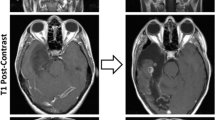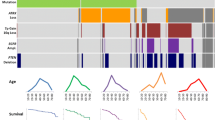Abstract
According to the 2016 World Health Organization Classification of Tumors of the Central Nervous System (2016 CNS WHO), IDH-mutant astrocytic gliomas comprised WHO grade II diffuse astrocytoma, IDH-mutant (AIIIDHmut), WHO grade III anaplastic astrocytoma, IDH-mutant (AAIIIIDHmut), and WHO grade IV glioblastoma, IDH-mutant (GBMIDHmut). Notably, IDH gene status has been made the major criterion for classification while the manner of grading has remained unchanged: it is based on histological criteria that arose from studies which antedated knowledge of the importance of IDH status in diffuse astrocytic tumor prognostic assessment. Several studies have now demonstrated that the anticipated differences in survival between the newly defined AIIIDHmut and AAIIIIDHmut have lost their significance. In contrast, GBMIDHmut still exhibits a significantly worse outcome than its lower grade IDH-mutant counterparts. To address the problem of establishing prognostically significant grading for IDH-mutant astrocytic gliomas in the IDH era, we undertook a comprehensive study that included assessment of histological and genetic approaches to prognosis in these tumors. A discovery cohort of 211 IDH-mutant astrocytic gliomas with an extended observation was subjected to histological review, image analysis, and DNA methylation studies. Tumor group-specific methylation profiles and copy number variation (CNV) profiles were established for all gliomas. Algorithms for automated CNV analysis were developed. All tumors exhibiting 1p/19q codeletion were excluded from the series. We developed algorithms for grading, based on molecular, morphological and clinical data. Performance of these algorithms was compared with that of WHO grading. Three independent cohorts of 108, 154 and 224 IDH-mutant astrocytic gliomas were used to validate this approach. In the discovery cohort several molecular and clinical parameters were of prognostic relevance. Most relevant for overall survival (OS) was CDKN2A/B homozygous deletion. Other parameters with major influence were necrosis and the total number of CNV. Proliferation as assessed by mitotic count, which is a key parameter in 2016 CNS WHO grading, was of only minor influence. Employing the parameters most relevant for OS in our discovery set, we developed two models for grading these tumors. These models performed significantly better than WHO grading in both the discovery and the validation sets. Our novel algorithms for grading IDH-mutant astrocytic gliomas overcome the challenges caused by introduction of IDH status into the WHO classification of diffuse astrocytic tumors. We propose that these revised approaches be used for grading of these tumors and incorporated into future WHO criteria.




Similar content being viewed by others
References
Aoki K, Nakamura H, Suzuki H et al (2018) Prognostic relevance of genetic alterations in diffuse lower-grade gliomas. Neurooncology 20:66–77
Balss J, Meyer J, Mueller W, Korshunov A, Hartmann C, von Deimling A (2008) Analysis of the IDH1 codon 132 mutation in brain tumors. Acta Neuropathol 116:597–602
Burger PC, Vogel FS, Green SB, Strike TA (1985) Glioblastoma multiforme and anaplastic astrocytoma, pathologic criteria and prognostic implications. Cancer 56:1106–1111
Cancer Genome Atlas Research N, Brat DJ, Verhaak RG et al (2015) Comprehensive, integrative genomic analysis of diffuse lower-grade gliomas. N Engl J Med 372:2481–2498
Capper D, Jones DTW, Sill M et al (2018) DNA methylation-based classification of central nervous system tumours. Nature 555:469–474
Capper D, Zentgraf H, Balss J, Hartmann C, von Deimling A (2009) Monoclonal antibody specific for IDH1 R132H mutation. Acta Neuropathol 118:599–601
Colman H, Giannini C, Huang L et al (2006) Assessment and prognostic significance of mitotic index using the mitosis marker phospho-histone H3 in low and intermediate-grade infiltrating astrocytomas. Am J Surg Pathol 30:657–664
Daumas-Duport C, Scheithauer B, O’Fallon J, Kelly P (1988) Grading of astrocytomas. A simple and reproducible method. Cancer 62:2152–2165
Draaisma K, Wijnenga MM, Weenink B, Gao Y, Smid M, Robe P, van den Bent MJ, French PJ (2015) PI3 kinase mutations and mutational load as poor prognostic markers in diffuse glioma patients. Acta Neuropathol Commun 3:88
Duregon E, Bertero L, Pittaro A et al (2016) Ki-67 proliferation index but not mitotic thresholds integrates the molecular prognostic stratification of lower grade gliomas. Oncotarget 7:21190–21198
Hsu DW, Louis DN, Efird JT, Hedley-Whyte ET (1997) Use of MIB-1 (Ki-67) immunoreactivity in differentiating grade II and grade III gliomas. J Neuropathol Exp Neurol 56:857–865
Kernohan JW, Mabon RF, Svien HJ, Adson AW (1949) A simplified classification of gliomas. Proc Staff Meet Mayo Clin 24:71–75
Louis D, Ohgaki H, Wiestler O, Cavenee W (2007) World Health Organization classification of tumours of the central nervous system. In: Bosman F, Jaffe E, Lakhani S, Ohgaki H (eds) World Health Organization classification of tumours, 4th edn. IARC, Lyon
Louis D, Ohgaki H, Wiestler O, Cavenee WK (2016) World Health Organization classification of tumours of the central nervous system. In: Bosman F, Jaffe E, Lakhani S, Ohgaki H (eds) World Health Organization classification of tumours revised, 4th edn. IARC, Lyon
Louis DN, Edgerton S, Thor AD, Hedley-Whyte ET (1991) Proliferating cell nuclear antigen and Ki-67 immunohistochemistry in brain tumors: a comparative study. Acta Neuropathol 81:675–679
Louis DN, Perry A, Burger P et al (2014) International Society of Neuropathology-Haarlem consensus guidelines, for nervous system tumor classification and grading. Brain Pathol 24:429–435
Louis DN, Perry A, Reifenberger G et al (2016) The 2016 world health organization classification of tumors of the central nervous system: a summary. Acta Neuropathol 131:803–820
Louis DN, von Deimling A (2017) Grading of diffuse astrocytic gliomas: Broders, Kernohan, Zulch, the WHO… and Shakespeare. Acta Neuropathol 134:517–520
Louis DN, Wesseling P, Paulus W et al (2017) cIMPACT-NOW update 1: not otherwise specified (NOS) and not elsewhere classified (NEC). Acta Neuropathol 135:481–484
Olar A, Wani KM, Alfaro-Munoz KD et al (2015) IDH mutation status and role of WHO grade and mitotic index in overall survival in grade II-III diffuse gliomas. Acta Neuropathol 129:585–596
Parsons DW, Jones S, Zhang X et al (2008) An integrated genomic analysis of human glioblastoma multiforme. Science 321:1807–1812
Pekmezci M, Rice T, Molinaro AM et al (2017) Adult infiltrating gliomas with WHO 2016 integrated diagnosis: additional prognostic roles of ATRX and TERT. Acta Neuropathol 133:1001–1016
Perry A, Nobori T, Ru N, Anderl K, Borell TJ, Mohapatra G, Feuerstein BG, Jenkins RB, Carson DA (1997) Detection of p16 gene deletions in gliomas: a comparison of fluorescence in situ hybridization (FISH) versus quantitative PCR. J Neuropathol Exp Neurol 56:999–1008
Pfaff E, Kessler T, Balasubramanian GP et al (2017) Feasibility of real-time molecular profiling for patients with newly diagnosed glioblastoma without MGMT promoter-hypermethylation—the NCT Neuro Master Match (N2M2) pilot study. Neuro Oncol. https://doi.org/10.1093/neuonc/nox216
Purkait S, Jha P, Sharma MC, Suri V, Sharma M, Kale SS, Sarkar C (2013) CDKN2A deletion in pediatric versus adult glioblastomas and predictive value of p16 immunohistochemistry. Neuropathology 33:405–412
Reis GF, Pekmezci M, Hansen HM et al (2015) CDKN2A loss is associated with shortened overall survival in lower-grade (World Health Organization Grades II–III) astrocytomas. J Neuropathol Exp Neurol 74:442–452
Reuss DE, Kratz A, Sahm F et al (2015) Adult IDH wild type astrocytomas biologically and clinically resolve into other tumor entities. Acta Neuropathol 130:407–417
Reuss DE, Mamatjan Y, Schrimpf D et al (2015) IDH mutant diffuse and anaplastic astrocytomas have similar age at presentation and little difference in survival: a grading problem for WHO. Acta Neuropathol 129:867–873
Roy DM, Walsh LA, Desrichard A, Huse JT, Wu W, Gao J, Bose P, Lee W, Chan TA (2016) Integrated genomics for pinpointing survival loci within arm-level somatic copy number alterations. Cancer Cell 29:737–750
Schneider CA, Rasband WS, Eliceiri KW (2012) NIH Image to ImageJ: 25 years of image analysis. Nat Methods 9:671–675
Sommer C, Strähle C, Köthe U, Hamprecht FA (2011) Ilastik: interactive learning and segmentation toolkit. In: Eighth IEEE international symposium on biomedical imaging (ISBI). IEEE, Chicago, pp 230–233
Sturm D, Witt H, Hovestadt V et al (2012) Hotspot mutations in H3F3A and IDH1 define distinct epigenetic and biological subgroups of glioblastoma. Cancer Cell 22:425–437
Suzuki H, Aoki K, Chiba K et al (2015) Mutational landscape and clonal architecture in grade II and III gliomas. Nat Genet 47:458–468
von Deimling A, Ono T, Shirahata M, Louis D (2018) Grading of diffuse astrocytic gliomas: a review of studies before and after the advent of IDH testing. Semin Neurol 38:19–23
Watanabe T, Nobusawa S, Kleihues P, Ohgaki H (2009) IDH1 mutations are early events in the development of astrocytomas and oligodendrogliomas. Am J Pathol 174:653–656
Wick W, Hartmann C, Engel C et al (2009) NOA-04 randomized phase III trial of sequential radiochemotherapy of anaplastic glioma with procarbazine, lomustine, and vincristine or temozolomide. J Clin Oncol 27:5874–5880
Yan H, Parsons DW, Jin G et al (2009) IDH1 and IDH2 mutations in gliomas. N Engl J Med 360:765–773
Zülch KJ (1979) Histological typing of tumours of the central nervous system. Who’s Who, London
Acknowledgements
This work was supported by German Cancer Aid (70112371) to AvD and German Cancer Aid (110624) to WW and MW. We are indebted to Toshio Sasajima, Masaya Oda and Masataka Takahashi for support regarding clinical data acquisition. We thank Viktoria Zeller, Ulrike Lass, Antje Habel, Ulrike Vogel, Katja Brast, Kerstin Lindenberg, John Moyers and Jochen Meyer for excellent technical assistance. We also thank the Microarray unit of the Genomics and Proteomics Core Facility, German Cancer Research Center (DKFZ), especially Matthias Schick, Roger Fischer, Nadja Wermke and Anja Schramm-Glück, for providing methylation services.
Author information
Authors and Affiliations
Corresponding author
Electronic supplementary material
Below is the link to the electronic supplementary material.
401_2018_1849_MOESM1_ESM.pptx
Supplementary Fig. 1 Copy number summary plots. Vertical axis indicates percentage of patients affected. Horizontal axis refers to chromosomal localization. Dotted vertical lines indicate border between p and q arms. Data are given for three age groups (PPTX 352 kb)
401_2018_1849_MOESM2_ESM.pptx
Supplementary Fig. 2 Kaplan–Meier plots stratifying by unsupervised clustering in the discovery set (a), the HD validation set (b) and the EORTC validation set (c). Kaplan–Meier plots stratifying by the methylation based classifier in the discovery set (d), the HD validation set (e) and the EORTC validation set (f) (PPTX 280 kb)
401_2018_1849_MOESM3_ESM.pptx
Supplementary Fig. 3 OS of subgroups in Modelcombined. The patient set (n = 7) characterized by necrosis, absence of CDKN2A/B homozygous deletion and low CNVL exhibited only 2 events. While the corresponding curve (red) fits well the group of patients with intermediate OS, the number is too low for a clear statement (PPTX 150 kb)
401_2018_1849_MOESM4_ESM.pptx
Supplementary Fig. 4 Association of proliferation markers with CDKN2A/B status. (a) association with Ki67. (b) association with pHH3. Horizontal bars in box-plots correspond to median values (PPTX 166 kb)
401_2018_1849_MOESM5_ESM.pptx
Supplementary Fig. 5 OS of patients with IDH-mutant astrocytoma in association with RB pathway genes. (a) red -homozygous deletion of CDKN2A/B, black – wild type status. (b) red –homozygous deletion of RB1 or CDK4 amplification or CDK6 amplification, black – wild type status.. (a) red -homozygous deletion of CDKN2A/B or homozygous deletion of RB1 or CDK4 amplification or CDK6 amplification, black – wild type status for all (PPTX 100 kb)
401_2018_1849_MOESM7_ESM.docx
Supplementary Table 1 Discovery set data employed in grading schemes for IDH-mutant astrocytoma. For each scheme lowest grade is indicated by green, intermediate grade by blue and highest grade by red color (DOCX 66 kb)
401_2018_1849_MOESM8_ESM.docx
Supplementary Table 2 Possible designation of IDH-mutant astrocytoma based on Modelpath in a future classification scheme (DOCX 13 kb)
Rights and permissions
About this article
Cite this article
Shirahata, M., Ono, T., Stichel, D. et al. Novel, improved grading system(s) for IDH-mutant astrocytic gliomas. Acta Neuropathol 136, 153–166 (2018). https://doi.org/10.1007/s00401-018-1849-4
Received:
Revised:
Accepted:
Published:
Issue Date:
DOI: https://doi.org/10.1007/s00401-018-1849-4




